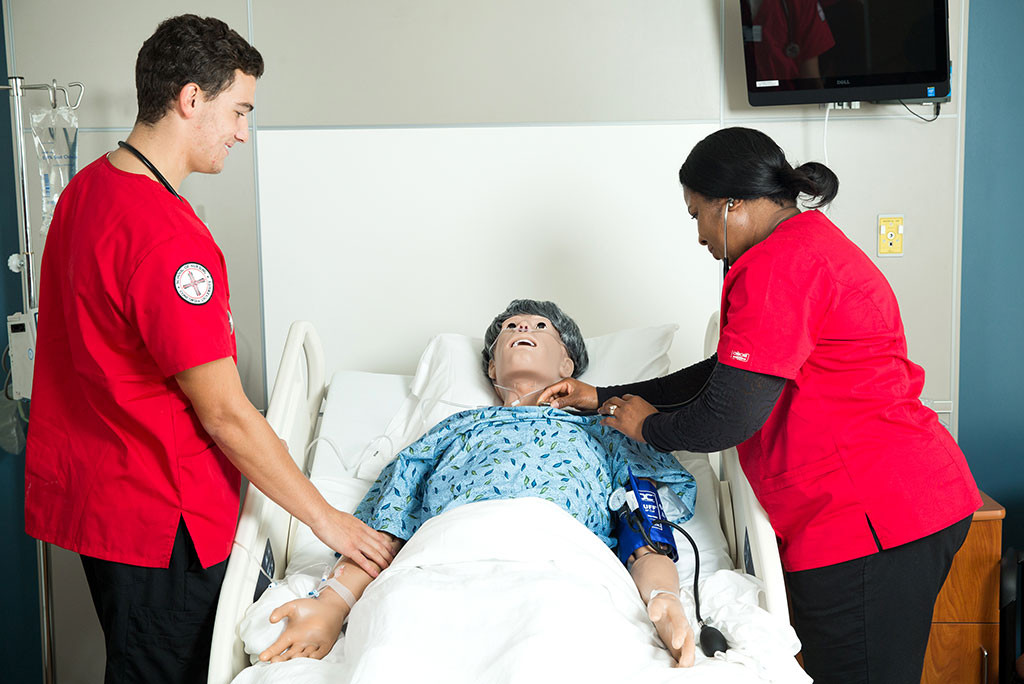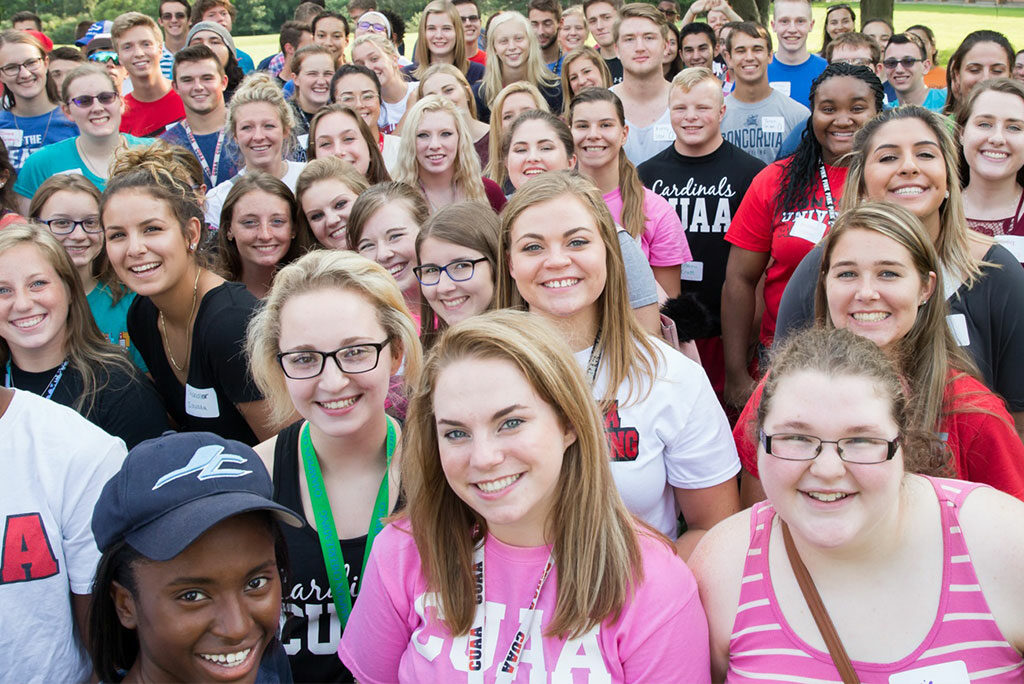
By Paula Schlueter Ross (paula.ross@lcms.org)
Even though total 2016 fall enrollment for The Lutheran Church—Missouri Synod’s 10 colleges and universities combined has fallen for the first time in 24 years, there’s no reason to panic, notes Concordia University System President Rev. Dr. Dean O. Wenthe.
That decline — in the context of so many years of growth — “is not too great a surprise inasmuch as the competition for students in higher education has increased dramatically in the last few years,” Wenthe says.
The total (in both graduate and undergraduate enrollments) is 35,717 — a decrease of 1,590 students, or 4.3 percent, from fall 2015.
Individual graduate and undergraduate enrollment totals also showed losses — of 1,403 students (down 6.9 percent) and 187 students (down 1.1 percent), respectively.
Decreases in fall “headcounts” — experienced by four of the 10 Concordia University System (CUS) schools this year — is attributed to a number of different factors, according to CUS staff and the schools’ spokespersons. Those factors include tuition freezes by state universities (making them more financially attractive to prospective students), marketplace trends regarding the demand for graduate degrees and data that suggest fewer students are seeking a private-school education.
In Wenthe’s view, the drop in overall CUS enrollment this year “does not suggest a trend” and could very well turn around by next fall.
“Why? We have a very gifted group of [CUS] presidents who are already addressing the challenge in fresh and meaningful ways,” he told Reporter. “For example, one university is already reporting a significant spike in prospective students for the fall of 2017.”
‘A front-burner concern’
What has been a trend — and a concern to Synod leaders for many years — is the continuing drop in the number of students pursuing church-work vocations.
This fall’s total of 1,331 church-work students is 24 fewer than last year — with drops among those studying to become pastors (a total of 170, down 7), teachers (822, down 15), directors of Christian education (204, down 3), lay ministers (41, down 3) and directors of family life ministry (34, down 2). The only church vocation with more students this year is director of parish music (23, up 6), and two others stayed the same: director of Christian outreach (with 5 students) and deaconess (with 32).
Wenthe acknowledges that “the task of attracting young men and women into church vocations is a front-burner concern throughout the church.”
The solution, he says, “will be multifaceted and will include enriching the culture of the church by honoring and encouraging its full-time workers, identifying and supporting gifted youth early, appealing to their idealism and courage as Christian youth, and more clearly underscoring the privilege of devoting a life to God and to matters eternal — wherein not only are lives made authentic in this world, but souls are delivered into Christ’s life for eternal joy.”
New record at Ann Arbor
Among the bright spots in this year’s enrollment report is Concordia University at Ann Arbor, Mich. (CUAA) — part of Concordia University Wisconsin, Mequon, since 2012 — which recorded an all-time high this fall with an enrollment of 1,054, the largest in the history of the school, which began operation as a two-year college in 1963.
The total — an increase of 17 percent over last year — is up 42 percent from the fall 2013 census.
CUAA welcomed 325 new students this fall, the largest incoming class since 1976, when the school began offering four-year bachelor of arts degrees.
Concordia, Ann Arbor, entered into a legal affiliation with the larger and more successful Concordia Wisconsin after struggling for years with financial, enrollment and administrative difficulties that threatened to close the university’s doors forever.
“The growth at Concordia has been very positive and the trajectory for continued growth is encouraging,” said President Rev. Dr. Patrick T. Ferry, who oversees both campuses and credits CUAA’s “new academic programs, enhanced facilities and terrific people” as “part of the draw for prospective students.”
Since 2013, CUAA has put millions of dollars toward renovations of academic buildings, and construction of the Cardinal Stadium athletic facility was completed in 2015. The school also acquired an 84,500-square-foot building north of its main campus that houses the new School of Nursing and athletic training programs.
Also new are computer science, special education and additional business majors, bringing undergraduate programs to a total of 47. Nineteen graduate programs include new offerings in student personnel administration in higher education, computer science and special education.
Positive results of recent surveys of student satisfaction and spiritual life at Concordia, Ann Arbor, “demonstrate the tremendous progress” of the school in recent years, according to Curt Gielow, campus chief executive.
And as part of Concordia Wisconsin — by far, the Concordia University System school with the largest enrollment — CUAA also offers “the Luther Promise,” a scholarship guarantee launched Oct. 13 that provides qualified undergraduate students between $16,000 and $20,000 annually.
That’s just one step the Ann Arbor, Mich., and Mequon, Wis., campuses are taking to attract more students, says Ferry, acknowledging this fall’s 7 percent dip in enrollments at Concordia Wisconsin.
The schools’ efforts in online marketing and admissions also have intensified, and the Wisconsin campus is currently up more than 500 applications for fall 2017 over this year and “expects to see that trend continue throughout the fall recruiting season,” he says.
Addressing questions ‘that matter most’
This year marks the eighth in a row of combined undergraduate and graduate enrollment exceeding 5,000 students at Concordia University Chicago (CUC) in River Forest, Ill., and a new record of 5,603 students was set this fall, notes CUC President Rev. Dr. Daniel L. Gard.
Like Concordia Wisconsin — and several other CUS schools — Concordia Chicago offers scholarships of up to $20,000 per year to eligible Lutheran students and graduates of Lutheran high schools, and has expanded its list of degree programs (recent additions include bachelor’s degrees in Computer Science, Classical Liberal Studies and Health Informatics and Information Management; a master’s in Computer Science; and a doctorate in Business Administration). And a new state-of-the-art residence hall is currently under construction, with an anticipated completion date of August 2017.
“The value of a Lutheran, liberal arts-based education, grounded in the Gospel of Jesus Christ, remains exceptionally strong among undergraduate students,” Gard told Reporter. “At the same time, Concordia Chicago is reaching growing numbers of master’s and doctoral students via cutting-edge technology that enables students to study from virtually anywhere, as well as on campus.
“As the church’s university in service to the LCMS, Concordia Chicago reaches the world with the gift of a Christ-centered education.”
That “Christ-centered education” — the hallmark of every Concordia college and university — far outweighs what secular schools have to offer, according to CUS President Wenthe.
He notes that in a recent issue of The Chronicle of Higher Education Review, two philosophy professors at state universities “raise a fundamental question concerning university education”: “Are we teaching [our students] everything without teaching them anything regarding the big questions that matter most? Is there a curriculum that addresses why we are here?”
Says Wenthe: “The Concordia universities of The Lutheran Church—Missouri Synod exist for that very reason, i.e., to present the truth that human beings are created in God’s image and that each and every person is the object of God’s affection and redemptive action in the life, death and resurrection of Jesus of Nazareth.”
The Synod’s CUS schools, Wenthe adds, “witness to these truths in a winsome and substantive manner that entails rigorous scholarship while also inviting all into the wonder of God’s grace and mercy in Christ. Unlike … much of contemporary higher education, the Concordias address the big questions that matter most.
“The fruit of attending such a university are lives that by God’s grace are rich in their love of God and their service to their neighbor.
“No university — no matter how prestigious — could offer something more valuable and beneficial.”
Individual enrollments
This fall’s enrollments — including both graduate and undergraduate students — at individual CUS schools are as follows:
- Concordia University, Ann Arbor, Mich. — 1,054 (an increase of 154 students over fall 2015).
- Concordia University Texas, Austin — 2,730 (up 160).
- Concordia College—New York, Bronxville — 1,185 (up 29).
- Concordia University Irvine, Irvine, Calif. — 4,299 (down 206).
- Concordia University Wisconsin, Mequon — 7,721 (down 547).
- Concordia University Portland, Portland, Ore. — 5,455 (down 1,727).
- Concordia University Chicago, River Forest, Ill. — 5,603 (up 365).
- Concordia College Alabama, Selma — 378 (down 273).
- Concordia University, St. Paul, Minn. — 4,535 (up 155).
- Concordia University, Nebraska, Seward — 2,757 (up 300).
For more information about LCMS colleges and universities — and professional church-work careers — visit the website of the Concordia University System at lcms.org/cus. To watch a video about CUS schools, visit thelc.ms/CUS-video.
Posted January 4, 2017
